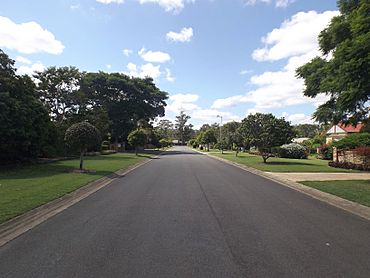Belivah, Queensland facts for kids
Quick facts for kids BelivahLogan City, Queensland |
|||||||||||||||
|---|---|---|---|---|---|---|---|---|---|---|---|---|---|---|---|

Stubbin Street, 2016
|
|||||||||||||||
| Population | 515 (2021 census) | ||||||||||||||
| • Density | 156.1/km2 (404/sq mi) | ||||||||||||||
| Postcode(s) | 4207 | ||||||||||||||
| Area | 3.3 km2 (1.3 sq mi) | ||||||||||||||
| Time zone | AEST (UTC+10:00) | ||||||||||||||
| Location |
|
||||||||||||||
| LGA(s) | Logan City | ||||||||||||||
| State electorate(s) | Logan | ||||||||||||||
| Federal Division(s) | Forde | ||||||||||||||
|
|||||||||||||||
Belivah is a small area, also called a suburb, located in the City of Logan, Queensland, Australia. In 2021, about 515 people lived there.
Where is Belivah?
Belivah is in Queensland, Australia. A main road called the Beaudesert–Beenleigh Road runs along its eastern side. This road helps people get around the area.
A Look Back: Belivah's History
Belivah gets its name from an Aboriginal word. It means "big fella fighting ground." We don't know the exact Aboriginal language it came from.
In December 1872, a church opened in Belivah. It was a small building made of hardwood.
Around 1874, a school called Belivah Provisional School started. Classes were held in the church building. Later, people wanted the school moved closer to where more children lived. In 1892, the community helped build a new school. It was renamed Wolffdene Provisional School. This school became Wolffdene State School in 1909. It closed for good in 1942.
Belivah officially became a named place in 1985. New houses started to be built in 1991. In 2003, Belivah was officially made a suburb.
Who Lives in Belivah?
The number of people living in Belivah has grown over time.
- In 2011, there were 323 people.
- In 2016, the population was 317.
- By 2021, it grew to 515 people!
Most people in Belivah were born in Australia. Other people came from countries like England, New Zealand, and Germany. Most residents speak English at home. Some also speak other languages like Mandarin or Finnish.
Learning in Belivah
Belivah does not have its own schools. Students usually go to schools in nearby areas.
- The closest primary school is Windaroo State School. It is in Mount Warren Park.
- The closest high school is Windaroo Valley State High School. It is in Bahrs Scrub.


